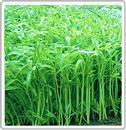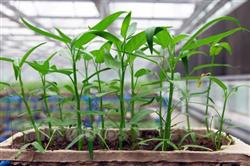Key points of cultivation and Management of High quality and High yield of Ipomoea aquatica

Water spinach, also known as water spinach, Tongcai or rattan vegetables, is a fast-growing green leafy vegetable introduced more in recent years. The technical points are as follows: 1. Sowing: direct seeding in the open field, seedling transplanting can be carried out, and the sowing period is generally in the middle and late April. Direct seeding on the ground can be done by drilling or dibbling, row spacing 30~35 cm, hole spacing 15~20 cm, dibbling 3~4 seeds per hole, watering immediately after sowing, seedling can emerge in about 7 days; it can also be sown densely, and plucked and harvested when the seedling height is 17~20 cm. After sowing, cover plastic film to warm up and keep moisture, and remove the film after seedlings emerge. In addition, can also be picked during the growth of about 15 cm of the top shoot cutting propagation, as long as the cutting field soil moisture appropriate, cuttings will soon grow adventitious roots, and out of new shoots. 2. Planting and management: water spinach on the soil conditions are not strict, should choose low-lying, moist soil and fertile clay loam cultivation. Early should be timely tillage loose soil, improve ground temperature. In summer, the temperature is high, the plant grows fast, and the fertilizer and water requirements are large. It is necessary to water frequently, irrigate with large water (dry air, insufficient soil moisture, easy to lead to increased fiber of spinach, affecting yield and quality), and combine watering for topdressing. Autumn temperature turns cool, to timely intertillage weeding and topdressing, and pay attention to the prevention and control of red spiders and other pests. Water spinach harvest period is long, generally after each harvest, should combine watering mu ammonium sulfate 10 kg. 3. Harvest: timely harvest is the key to high yield and high quality of water spinach. In production, it can be harvested when the seedling height is about 20~30 cm. During the first and second harvest, 2~3 nodes should be reserved at the base of the stem to facilitate the germination of new buds after harvest, promote lateral branches and strive for high yield. After harvesting 3~4 times, the plant should be re-harvested once, that is, only 1~2 nodes should be left at the base of the stem to prevent excessive lateral branches and slow growth.
- Prev

Cultivation and management techniques of asparagus
Asparagus, also known as bamboo leaf vegetable, macaroni, water spinach, water spinach or rattan vegetable, is a kind of fast-growing green leafy vegetable introduced actively in recent years. The main management techniques are as follows: (1) the seed coat of cultivated seedlings is relatively thin and not hard, absorbs water faster, and dry seeds can be sown and germinated. Sprouting and sowing. ...
- Next

How to apply fertilizer to asparagus
Asparagus is not strict on soil, but the soil with sufficient water and fertilizer and strong water and fertility is more advantageous. Asparagus vine leaves grow rapidly, requiring a large amount of fertilizer and strong fertilizer tolerance. If there is sufficient fertilizer and water, high quality and high yield can be obtained, but fertilizer and water should be controlled in the planting land, otherwise it is easy to grow and not blossom. The basic fertilizer of asparagus is soil manure and manure.
Related
- Where is it suitable to grow horseradish in China? it is expected to see the middle altitude horseradish in Alishan.
- How to prevent tomato virus disease reasonably? (Control methods included)
- Many people like to plant towel gourd on the balcony. What are the main points of this method and management?
- What crops can chili peppers be mixed with?
- Fertilization techniques and matters needing attention in Tomato
- What are the grafting techniques for peach seedlings in spring?
- Harm and control methods of root swelling disease of Chinese cabbage
- What are the pests of sweet potatoes? How to prevent and cure it?
- Symptoms, causes and Control methods of navel Rot in Tomato
- The cause of "Cucumber rotten bibcock" in Farmers' planting Cucumber and its Control Plan

